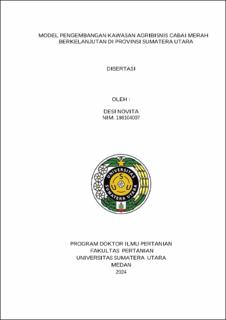| dc.description.abstract | The purpose of this study was to determine the level of risk in Red Chili farming in North Sumatra Province, the sustainability status seen from the dimensions of Economy, Socio-Culture, Environment, Institutions and Partnerships, the dominance of attributes of the Economy, Socio-Culture, Environment, Institutions, and Partnerships that influence the development of Red Chili agribusiness areas in North Sumatra Province and to form a model for the development of sustainable Red Chili agribusiness areas in North Sumatra Province.
This study was conducted in North Sumatra Province which covers 33 regencies/cities. The data used in this study are primary data and secondary data. This study uses several data analysis methods, namely Static Location Quotient (SLQ) and Dynamic Location Quotient (DLQ) analysis to determine superior commodities. The risk analysis carried out in this study is the risk of producer-level prices, consumer-level price risks, and production risks. Measurement of the level of risk is carried out by measuring the value of deviations that occur in prices and production, namely by measuring the variables of productivity and red chili prices. Risk assessment can be carried out by determining the value of variance, standard deviation, and coefficient of variation. The method used in this study is Multi Dimensional Scaling (MDS) which is modified to determine the sustainability of the development of horticultural agribusiness areas in the research area. Meanwhile, the area development model is analyzed using System Dynamics.
Based on the results of the data analysis, it was obtained that North Sumatra Province is a province that has an advantage in red chili commodities with 5 districts that make red chili a superior commodity, namely Batubara, Simalungun, Dairi, Mandailing Natal and Langkat Regencies. Based on the analysis of the level of production risk, it can be seen that the risk of red chili production is low. Meanwhile, for the level of red chili price risk, it can be seen that the price risk at the retailer/consumer level is greater than the price risk at the producer level. The red chili agribusiness system in North Sumatra Province is in a fairly sustainable status. Viewed from the dimension side, there are four dimensions, namely the economic, socio-cultural, institutional and partnership dimensions that are included in the fairly sustainable category. While the environmental dimension is in a very sustainable status. The dominant attributes that influence the red chili agribusiness system in North Sumatra Province for each dimension are (1) The environmental dimension is influenced by the conversion of agricultural land to non-agricultural land, the suitability of land and land quality for red chili plants, and the use of organic fertilizers that are quite good at the farmer level (2) The economic dimension is influenced by production costs, processing of derivative products, contributions to regional income and price stability at the consumer/retailer level (3) The socio-cultural dimension is influenced by the motivation of farmers to grow red chili which is very good, the intensity of land conflicts is low, and the level of education/skills of farmers towards the implementation of good Good Agriculture Practice (4) The partnership dimension is influenced by the involvement of farmer groups in agricultural planning, government protection of red chili prices, the role of universities and the impact of government policies and (5) The institutional dimension is influenced by the availability of risk-bearing institutions, the availability of derivative product processing institutions, government regulations and policies on the zoning of red chili development, and the role of agricultural extension workers.
The sustainable red chili agribusiness area development model in North Sumatra Province is built from three sub-models, namely the social, economic and environmental sub-models. The dynamic system model has been validated using the variables of harvested area, planted area, production, consumer price and producer price. All variables have met the validity so that the model can be used properly. The model without a scenario shows that in the period up to 2035, the harvested area, production, productivity, producer price, consumer price, production cost and income of red chili farmers tend to increase. Based on the results of the scenario which is divided into 3 scenarios, namely moderate, optimistic and pessimistic scenarios, it can be seen that the moderate scenario tends to be able to increase production, productivity, harvested area, reduce producer price and reduce consumer price.
Some things that can be recommended are (1) the government and stakeholders in the North Sumatra region are expected to try to apply and implement the scenarios that have been formulated in this study, (2) Every district that makes red chili a superior commodity needs to make efforts to develop sustainable commodity agribusiness areas | en_US |


